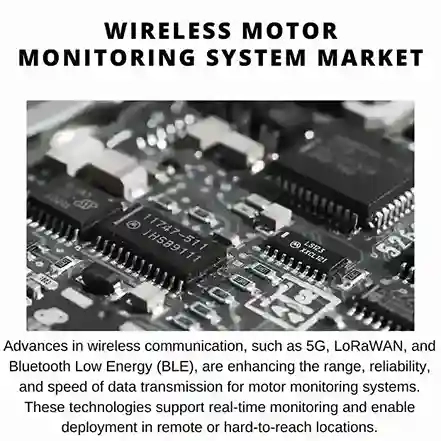
- Get in Touch with Us

Last Updated: Apr 25, 2025 | Study Period: 2024-2030
The global wireless motor monitoring system market is poised for significant growth over the next six years, with estimates suggesting a market size of USD xx billion in 2023 and reaching USD xx billion by 2030. This translates to a Compound Annual Growth Rate (CAGR) of xx%.
Innovations in the technology, wireless connectivity, AI integration, and energy harvesting are driving the evolution of motor monitoring, enabling more effective predictive maintenance and operational optimization across various industries. These advancements are helping companies improve equipment reliability, reduce downtime, and enhance overall productivity. Also, the technological advancements in wireless motor monitoring system have significantly expanded their capabilities, making them more accurate, reliable, and versatile.
Numerous sales opportunities and steadfast growth in Asia Pacific is driven due to multiple promising factors. Considerable efforts made by the industrial facility operators in the market to create an industry 4.0 ecosystem is paving a way for integration of motor monitoring system. In the recent times most of the facility operators are keen towards the implementation of predictive maintenance strategies in order to reduce the downtime in the facilities is attracting more customers towards the market.
Over the course of the projection period, the market for the automotive and transportation end-use category is expected to grow at the quickest rate. Automobile manufacturers must maintain a high level of production while concentrating on efficient quality management in light of shifting consumer preferences. For motors employed in machinery, this calls for favourable circumstances.
In addition, the automobile sector is emphasising the modernization and automation of assembly lines, necessitating constant motor monitoring to prevent downtime. To boost manufacturing output and shorten the production cycle without compromising product quality, the sector needs to maintain its equipment properly. These elements are all going to help the segment flourish.
Smart monitoring system with embedded microprocessors and digital signal processing (DSP) capabilities can perform complex data analysis directly at the sensor level. This reduces the need for external processing and speeds up decision-making. Sensors with onboard diagnostics can self-monitor their performance and report issues, ensuring reliable operation and reducing maintenance requirements.
Motor monitoring, which finds use in a variety of industry verticals, involves gathering, organising, and evaluating streaming data with the aid of detectors, sensors, diagnostic software, and other tools. By using wireless IoT sensors and cloud-based software for condition monitoring, industrial experts can now access temperature, vibration, and current data from anywhere in a plant at any time, enabling them to anticipate equipment issues and prevent downtime. This continues a trend that is propelling the market's expansion.
Innovations in wireless communication technologies (such as Wi-Fi, Bluetooth, LoRa, and NB-IoT) have significantly enhanced the reliability, range, and security of wireless monitoring systems, making them more attractive for industrial applications. The push towards digital transformation and the adoption of Industry 4.0 principles are major drivers. Wireless motor monitoring solutions fit seamlessly into the IoT ecosystem, enabling comprehensive data collection and analysis, predictive maintenance, and smart manufacturing processes.
While wireless motor monitoring systems are invaluable tools for monitoring and maintenance, they come with limitations related to environmental sensitivity, installation and calibration, data management, power supply, cost, interference, frequency range, durability, system integration, and security. Addressing these challenges involves careful planning, selecting the right sensor for the application, ensuring proper installation and maintenance, and leveraging advanced data analytics and cybersecurity measures. By understanding and mitigating these limitations, companies can maximize the benefits of vibration sensors and improve their operational efficiency and reliability.

The Global Wireless Motor Monitoring System Market accounted for $XX Billion in 2023 and is anticipated to reach $XX Billion by 2030, registering a CAGR of XX% from 2024 to 2030.
TMEIC Asia Pte. Limitedintroduced the Smart Motor Sensor, or "TMASMS," ahigh-performance predictive maintenance platform for electric motorsbased on artificial intelligence (AI). Under a channel partner agreement with the US-based Analogue Devices, Inc., sales started in March 2022. Additionally, TMEIC Asia started monitoring the entire paper machine's motors in April 2022 after completing the first delivery of 25 sets of TMASMS to PT. Bukit Muria Jaya.
A novelmotor monitoring systemhas been introduced byOneWatt, an industrial technology developer supported by InnoEnergy, Europe's engine of sustainable energy innovation, for the onshore and offshore wind, hydropower, and industrial sectors.
TheK7DD-PQ Series of sophisticated motor condition monitoring deviceshas been globally launched byOMRON Corporation, with the items being supplied starting in April 2023. The series is the newest member of OMRON's family of condition monitoring tools, which automates human workers' monitoring of anomalies on the manufacturing site. To minimise inspection effort and avert unplanned failure, the K7DD-PQ quantitatively tracks trends in the degradation and wear of servomotors, machine tools, and other equipment.

| Sr. No | Topic |
| 1 | Market Segmentation |
| 2 | Scope of the Report |
| 3 | Research Methodology |
| 4 | Executive Summary |
| 5 | Introduction |
| 6 | Average B-2-B Selling Price in Past 5 Years |
| 7 | Insights from Industry Stakeholders |
| 8 | Cost Breakdown of Product Components and Average Profit Margin |
| 9 | Disruptive Innovation in the Industry |
| 10 | Technological Innovations in Global wireless motor monitoring system Market 2024-2030 |
| 11 | Advancements in Automation Framework |
| 12 | Integration of AI and Machine Learning |
| 13 | Sensor Technology Innovations |
| 14 | Evolution of Predictive Maintenance |
| 15 | Adoption of Cloud Robotics Solutions |
| 16 | Progress in Wireless and IoT integration |
| 17 | Development of Robust Safety Features |
| 18 | Interoperability and Compatibility Improvements |
| 19 | Scalability and Modularity Enhancements |
| 20 | New Product Development in the Past 12 Months |
| 21 | Market Size, Dynamics, and Forecast by Geography (2024-2030) |
| 22 | Market Size, Dynamics, and Forecast by Offering(2024-2030) |
| 23 | Market Size, Dynamics, and Forecast by Deployment(2024-2030) |
| 24 | Market Size, Dynamics, and Forecast by Industry(2024-2030) |
| 25 | Competitive Landscape and Market Share Analysis |
| 26 | Growth Strategy of Leading Players |
| 27 | Market Share of Vendors (2023) |
| 28 | Company Profiles |
| 29 | Unmet Needs and Opportunities for New Suppliers |
| 30 | Conclusion |